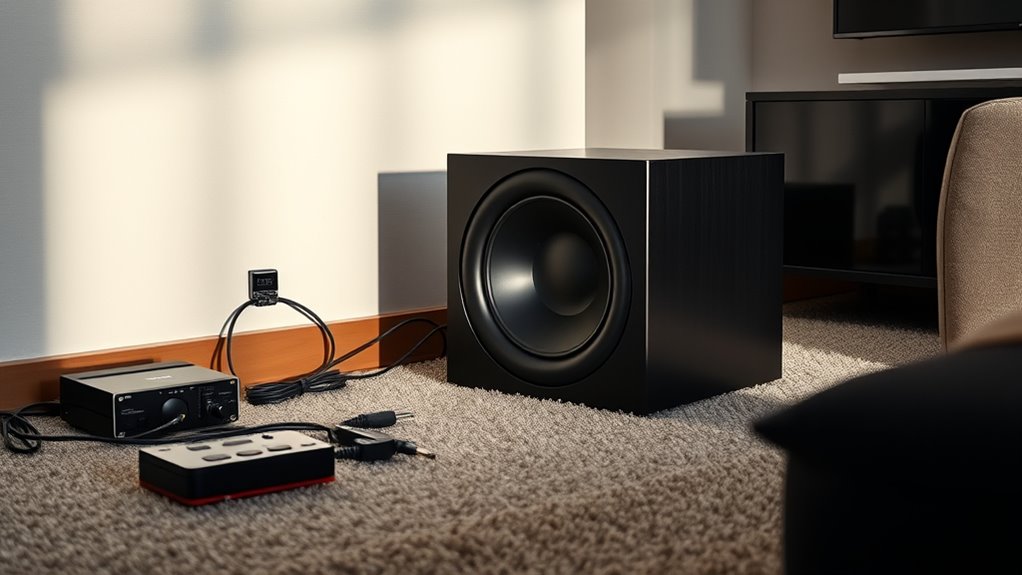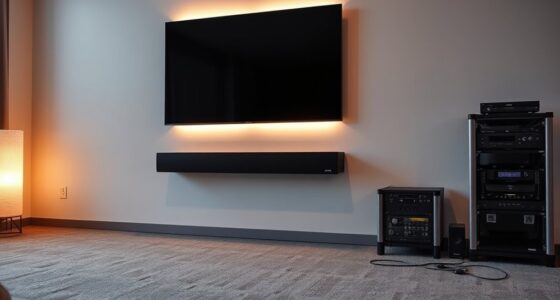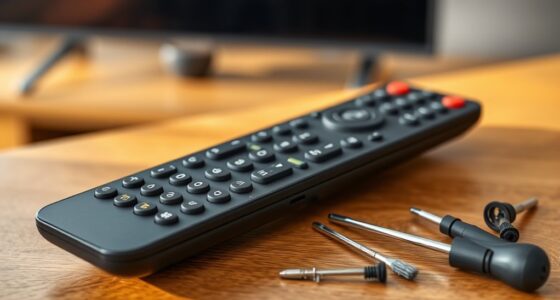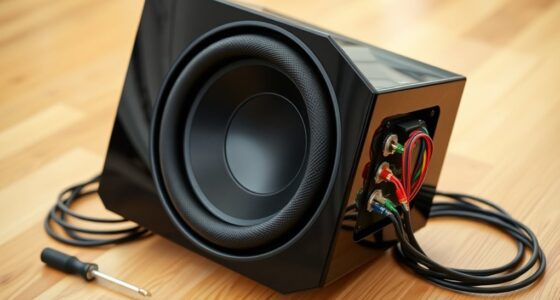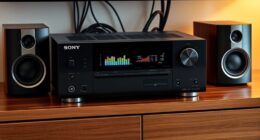Many people overlook subwoofer setup basics, making common mistakes like placing it too close to walls, which creates boomy bass, or neglecting room acoustics that cause muddy sound. Using low-quality cables or skipping calibration leads to weak or unbalanced bass. Relying on default crossover settings and ignoring furniture layout can cause muddiness or nulls. If you continue, you’ll discover how to optimize every step for the best sound experience.
Key Takeaways
- Proper placement avoids wall and corner proximity to prevent muddy, boomy bass.
- Calibrate volume, phase, and crossover settings for seamless integration with main speakers.
- Use high-quality, secure cables and check connections regularly to ensure reliable sound.
- Fine-tune level and test systematically with calibration tools for balanced, impactful bass.
- Avoid overemphasizing bass and maintain ongoing calibration to ensure long-term sound clarity and stability.
Incorrect Placement of the Subwoofer

Incorrect placement of the subwoofer can considerably impact your sound quality. The size of your subwoofer influences where it should go; larger models often need more space to avoid overwhelming the room, while smaller ones are more flexible. You might have brand preferences, but placement matters regardless of brand. Placing the subwoofer too close to walls or corners can cause boomy, muddy bass, whereas positioning it too far from your listening area can weaken the sound. Experiment with different spots, ideally near the main listening position but away from surfaces that reflect sound excessively. Remember, the goal is balanced, tight bass that complements your overall setup. Proper placement guarantees you get the best performance from your subwoofer, no matter its size or brand. Additionally, understanding the room acoustics can help you optimize the placement further for improved sound quality.
Ignoring Room Acoustics and Surfaces

Room acoustics and surface reflections play a vital role in how your subwoofer sounds, yet many people overlook this aspect. Ignoring these factors can lead to muddy, boomy bass or uneven sound distribution. Proper acoustic treatment helps control surface reflections, ensuring a clearer, more accurate bass response. Consider these points:
Room acoustics greatly influence subwoofer sound; proper treatment ensures clearer, more accurate bass.
- Use bass traps to absorb low-frequency reflections
- Add rugs or carpets to minimize surface reflections on floors
- Install wall panels to reduce echo and improve sound clarity
- Rearrange furniture to break up reflective surfaces
- Avoid placing the subwoofer near large, reflective surfaces like glass or bare walls
- Incorporate Self Watering Plant Pots to create a controlled environment that minimizes unwanted vibrations and resonances, which can affect sound quality.
Addressing room acoustics is essential for balanced sound. Ignoring this step can considerably hamper your subwoofer’s performance and overall listening experience.
Overlooking Proper Wiring and Connections

Even if your subwoofer is set up correctly, overlooking proper wiring and connections can considerably compromise its performance. Make certain all cables are secure and the connections match the subwoofer and receiver ports. With wireless subwoofers, double-check that the Wi-Fi or Bluetooth link is stable and correctly configured. Poor wiring can lead to signal loss or distortion, reducing bass clarity and impact. Additionally, consider subwoofer size considerations—larger models might need thicker cables or specific placement for ideal wiring. Avoid daisy-chaining multiple subwoofers without proper wiring plans, as this can cause phase issues or signal interference. Proper wiring and connection setup ensure your subwoofer operates smoothly, delivering the deep, powerful bass you expect. Don’t overlook this essential step in your setup process.
Failing to Calibrate the Subwoofer Settings

Properly calibrating your subwoofer settings is essential to achieving balanced and impactful bass. Skipping this step can result in muddy sound or overpowering lows that drown out other frequencies. Take time to fine-tune the volume, phase, and crossover frequency for ideal performance. Remember, a well-calibrated subwoofer enhances your entire listening experience, whether wired or wireless, and complements your subwoofer aesthetics. Be cautious of settings that cause distortion or uneven bass response, especially with wireless connectivity options. Additionally, understanding local resources and tools can help you access calibration devices or professional assistance to optimize your setup.
Relying Solely on Default Crossover Frequencies

Relying only on default crossover frequencies can limit your system’s flexibility and prevent it from delivering the best sound. When these settings overlap or aren’t tailored to your setup, it can create confusion and muddy the audio. Customizing your crossover settings helps optimize sound quality and guarantees a seamless listening experience.
Default Settings Limit Flexibility
Default crossover settings can severely limit your subwoofer’s performance because they are often designed for general use rather than your specific setup. Relying solely on these presets can prevent you from achieving ideal sound quality and flexibility. You might miss out on customizing the subwoofer insulation or adjusting for your room’s acoustics. Plus, default settings can restrict your options for wireless connectivity, making it harder to fine-tune your system. To improve performance, consider these steps:
- Adjust crossover frequency for your room size
- Fine-tune phase settings for balanced sound
- Experiment with subwoofer insulation placement
- Use custom EQ settings instead of defaults
- Explore manual controls rather than relying on auto modes
Additionally, understanding Personal Empowerment can help you take control of your audio system and make informed adjustments that match your preferences.
Overlapping Frequencies Cause Confusion
When you leave crossover settings at their default levels, overlapping frequencies can create confusion in your sound system. This overlap often leads to phase cancellation, where sound waves cancel each other out, reducing bass clarity and impact. Additionally, frequency masking occurs when higher frequencies drown out lower ones, making the bass less distinguishable. Relying solely on default crossover points means your subwoofer and main speakers might produce similar frequencies without proper adjustment, causing muddiness and loss of detail. To avoid this, you need to fine-tune crossover settings, ensuring that each speaker handles its designated frequency range. This prevents phase issues and frequency masking, resulting in a cleaner, more balanced sound that fully utilizes your system’s potential. Understanding speaker frequency response is essential for achieving a precise setup and optimal sound quality.
Customization Enhances Sound Quality
While it might seem convenient to leave your crossover settings at their factory defaults, doing so can limit your system’s true potential. Customizing your crossover frequency allows you to tailor sound output for your specific space and equipment, like your subwoofer enclosure and wireless connectivity options. Relying solely on default settings can cause muddled bass or gaps in sound. To optimize, try adjusting the crossover to match your room’s acoustics and speaker capabilities. Use these tips:
- Fine-tune crossover points for balanced bass and treble
- Experiment with different settings for your subwoofer enclosure
- Sync your wireless connectivity for seamless control
- Avoid overlapping frequencies that cause distortion
- Regularly recalibrate for consistent sound quality
Custom setup ensures your subwoofer performs at its best, delivering clear, punchy bass tailored to your environment.
Neglecting to Use a Subwoofer Level Control
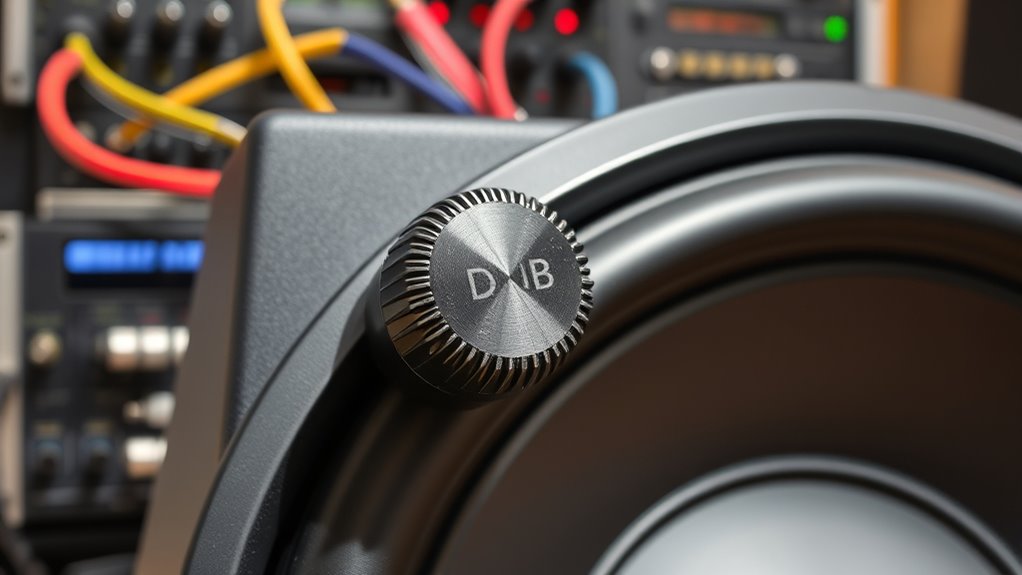
Ignoring the subwoofer level control can lead to volume imbalance between your speakers and bass. Without adjusting it properly, you might find the bass overpowering or too weak. Using the level control helps you achieve a balanced, clear sound. Additionally, proper airflow around your subwoofer can prevent overheating and maintain optimal performance.
Subwoofer Level Adjustment
Many people overlook the importance of adjusting the subwoofer level, which can lead to an unbalanced sound experience. If your subwoofer is too loud or too quiet, it disrupts the harmony with your main speakers, regardless of proper placement or room acoustics. Correct level adjustment ensures seamless integration and clear bass. Additionally, understanding how a high refresh rate impacts audio-visual synchronization can help optimize overall performance.
- Use a test tone or music with strong bass to find the right balance
- Start with the subwoofer volume halfway and tweak gradually
- Consider how room acoustics affect perceived bass loudness
- Adjust the phase and crossover settings for better blending
- Remember, subwoofer placement impacts level perception, so fine-tune accordingly
Proper level adjustment complements subwoofer placement, enhancing overall sound clarity and depth.
Preventing Volume Imbalance
Failing to use a dedicated subwoofer level control can quickly lead to volume imbalances that disrupt your overall sound quality. Without proper adjustment, the subwoofer might overpower or underwhelm your speakers, creating an uneven listening experience. To prevent this, ensure your subwoofer’s volume is fine-tuned alongside other components. Good cable management keeps connections tidy, reducing interference and accidental disconnections that could cause volume issues. Using speaker stands elevates your speakers, helping achieve a balanced soundstage and making it easier to hear discrepancies. Additionally, setting a clear hierarchy for adjusting levels helps maintain harmony: proper setup is essential for optimal audio performance.
| Aspect | Importance |
|---|---|
| Cable management | Ensures consistent signal flow, avoiding volume dips |
| Speaker stands | Provides accurate sound dispersion for balance |
| Subwoofer level | Prevents overpowering or weak bass signals |
| Overall setup | Maintains sound consistency across your system |
Placing the Subwoofer Too Close to Walls or Corners

Placing your subwoofer too close to walls or corners can lead to boomy, uneven bass that muddies your overall sound quality. This poor subwoofer placement skews room acoustics, causing certain frequencies to resonate excessively. To avoid this, consider these points:
- Keep the subwoofer at least a few inches away from walls
- Experiment with different corner positions for balanced bass
- Use a subwoofer isolation pad to reduce vibrations
- Avoid placing the sub near furniture that dampens sound
- Test different spots to find the smoothest, most natural bass response
- Be aware that room acoustics heavily influence subwoofer performance, so the placement should be strategic. Proper positioning ensures cleaner, more accurate bass, making your entire audio experience richer and more immersive.
Not Considering the Integration With Main Speakers

If your subwoofer doesn’t match your main speakers’ frequency response, your sound will feel unbalanced. You also need to set the right sound levels so everything blends smoothly instead of overpowering or vanishing. Ignoring these details can leave your audio muddy or disconnected. Additionally, understanding the angel number signals related to love and relationships can help you create a more harmonious listening environment by fostering a balanced setup that resonates with positive energy.
Matching Speaker Frequencies
Matching speaker frequencies is a essential step to guarantee your subwoofer blends well with your other speakers. Proper speaker matching ensures the frequency response of your system is smooth, preventing gaps or overlaps that can distort sound. To achieve this, consider the following:
- Check the frequency response range of your main speakers
- Ensure your subwoofer’s low-end capabilities complement your speakers
- Avoid frequency overlaps that cause muddiness
- Use a spectrum analyzer to visualize the frequency response
- Adjust crossover settings for seamless integration
Balancing Sound Levels
Once you’ve set your speaker frequencies, the next step is to balance your sound levels for ideal listening. Start by adjusting your subwoofer placement; aim for a position that minimizes localization and enhances bass response. Avoid placing it directly against walls or in corners, which can cause boomy or uneven bass. Next, fine-tune your crossover adjustment to blend the subwoofer smoothly with your main speakers. Set the crossover frequency to around 80Hz to 100Hz as a starting point, then listen for consistency and clarity. Use test tracks or bass-heavy music to gauge if the bass feels even and well-integrated. Adjust the volume control on your subwoofer until you achieve a balanced, punchy sound without overpowering your main speakers.
Overemphasizing Bass Without Balance

Overemphasizing bass can overshadow the overall sound balance, making your audio feel boomy and unnatural. Too much bass overemphasis creates a sound imbalance, where low frequencies dominate and drown out vocals or mids. This leads to a muddled listening experience and can strain your ears over time. To avoid this, focus on integrating your subwoofer smoothly with other speakers rather than boosting bass excessively. Properly tuning and positioning your subwoofer ensures a balanced soundstage. Remember, great sound isn’t just about loud bass—it’s about clarity and harmony across all frequencies. Keep these points in mind:
- Balance bass levels with mids and highs
- Use calibration tools for precision
- Avoid turning up bass to compensate for poor acoustics
- Regularly adjust for room changes
- Prioritize sound quality over volume
Ignoring the Impact of Furniture and Room Layout

Furniture and room layout can substantially affect your subwoofer’s performance, yet many overlook this factor. Furniture interference can block or diffuse bass waves, leading to uneven sound and reduced clarity. Large or bulky pieces near the subwoofer can absorb or reflect low frequencies, diminishing bass impact. Additionally, room shape effects play a vital role; irregularly shaped rooms can cause standing waves and bass nulls, creating dead spots or boomy areas. Ignoring these aspects often results in suboptimal sound quality. To optimize performance, position furniture thoughtfully and consider the room’s shape. Moving your subwoofer away from furniture interference points and experimenting with placement can help achieve a balanced, deep bass response. Don’t underestimate how your room’s layout influences your subwoofer’s overall sound.
Using Low-Quality Cables and Connectors

Using low-quality cables and connectors can considerably compromise your subwoofer’s sound quality. Poor connections lead to signal loss, noise, and reduced bass clarity. To guarantee peak performance, always choose high quality cables and proper connectors that match your equipment. Investing in good cables prevents interference and maintains signal integrity from the receiver to the subwoofer.
- Use shielded, low-loss cables to minimize interference
- Select proper connectors that fit securely and snugly
- Avoid cheap, thin cables prone to damage or signal degradation
- Check for corrosion or loose connections regularly
- Prioritize quality over price for long-term reliability
High quality cables and proper connectors are essential for delivering clean, powerful bass without distortion. Skimping here can undermine your entire setup, so choose wisely.
Skipping Test and Adjustment Procedures

Skipping test and adjustment procedures can lead to suboptimal bass performance and unresolved sound issues. Without proper test procedures, you won’t accurately gauge your subwoofer’s response or identify problem areas. Adjustment techniques are essential for fine-tuning your setup to match your room and preferences. Failing to perform these steps might result in muddy, boomy bass or gaps in sound coverage. Start by running test tones and checking for frequency response irregularities. Use an SPL meter or calibration tools to modify volume levels and crossover settings precisely. Don’t skip these steps, as they ensure your subwoofer delivers clear, balanced bass. Consistent testing and adjustments optimize performance and prevent common issues like distortion or uneven sound distribution.
Frequently Asked Questions
How Do I Choose the Best Subwoofer Placement for My Room?
To select the best subwoofer placement, start by considering room acoustics and speaker height. Place your sub near a wall or corner to enhance bass response, but avoid obstructing vents or windows. Experiment with different spots, listening for smooth, even bass. Keep the sub at ear level or slightly lower when seated, and adjust based on how the room’s acoustics influence sound. This ensures deep, balanced bass throughout your space.
What Are the Signs of Poor Subwoofer Integration With Main Speakers?
You’ll notice poor subwoofer integration when bass sounds disconnected or muddy, often caused by phase mismatch or bass bleed. If your main speakers sound less clear or the bass seems to overwhelm other frequencies, it’s a sign the subwoofer isn’t syncing properly. Adjusting the phase and positioning can fix this, ensuring tight, balanced sound. Don’t ignore these signs—they’re your cue to optimize your setup for better, seamless audio.
How Often Should I Recalibrate My Subwoofer Settings?
You should recalibrate your subwoofer settings at least every six months or whenever you notice changes in sound quality. During calibration, focus on frequency adjustment to guarantee the bass blends seamlessly with your main speakers. Regular calibration frequency helps maintain peak performance, especially if you move your setup or change room acoustics. Don’t wait too long—consistent recalibration keeps your sound balanced and immersive.
Can Furniture Placement Affect Subwoofer Sound Quality?
While it’s often overlooked, furniture placement can subtly influence your subwoofer’s sound quality. Avoiding furniture interference helps guarantee clearer bass, as bulky pieces or soft furnishings can absorb or diffuse sound waves. Consider how room acoustics interact with your subwoofer’s position. Rearranging furniture, or placing the subwoofer away from large objects, can dramatically enhance sound clarity and depth, giving you a more immersive listening experience.
What Are the Risks of Using Cheap Cables for Subwoofer Connections?
Using cheap cables for your subwoofer can lead to poor sound quality, as low-quality cable quality increases the risk of signal interference. This interference can cause buzzing, distortion, or loss of bass clarity. Additionally, cheap cables may have inadequate shielding, making them more susceptible to external noise. To guarantee ideal performance, invest in well-made cables that provide proper shielding and reliable connections, reducing interference and preserving sound quality.
Conclusion
Getting your subwoofer setup right can transform your home theater from good to mind-blowingly epic. Don’t fall into common traps like poor placement or ignoring calibration—those mistakes can turn your powerful bass into a soggy mess. Instead, follow these tips, use quality gear, and fine-tune your system. When you finally nail it, you’ll feel like you’ve revealed the secret to perfect sound—making every movie night feel like a personal concert!
